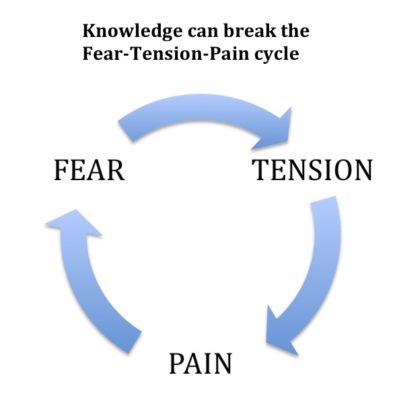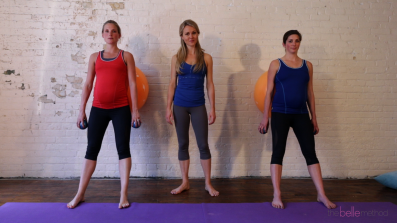When I took my doula certification course several years ago, we learned about the pain-fear-tension cycle during child birth. This is hugely powerful concept that illustrates the spiral that can happen when women experience fear surrounding birth. For most of our lives, we have been bombarded with negative stories of other women’s birth experiences and seen dramatic depictions in movies and on television. We have been conditioned to believe that excruciating pain is associated with labour; and because of this, most women I know fear giving birth. This fear can create a cycle of increased tension and pain. 
Here’s how it works: Fear creates muscle tension, and tension increases perceived levels of pain, which of course leads to more fear. This creates a cycle that inhibits the body from performing a normal physiological function. The result is exactly what’s feared most – long, painful birthing or unnecessary intervention.
Fear comes from both misinformation and the unknown – from cultural myths and questions never asked. Knowledge is power, and feeling powerful will reduce feelings of fear. Prenatal Pilates is an opportunity for women to receive the knowledge they need. They’ll learn how to trust in themselves and their bodies so they are prepared no matter what happens during their birth. Here’s a little bit of what we cover in The Bump Method Prenatal Pilates classes, both in person and on video.
Posture: learning how to position your body during pregnancy to reduce back and hip pain. Tip: ensure your pelvis is stacked under your rib cage instead of thrusted forward (very common as your growing belly can pull you out of good posture).
Breathing: learning how to connect your exhale to the contraction of your pelvic floor and your inhale to the release of your pelvic floor. The inhale is key for the pushing stage of labour. Tip: picture your pelvic floor gently dropping and opening as you inhale into your diaphragm, then initiate the push at the very end of your inhale.
Birth Positions: learning the best body movements and poses for encouraging the baby to descend during labour and delivery. Tip: being on hands and knees and gently rocking OR using 2 pool noodles ( yes, pool noodles) vertically under each of your pelvic bones while seated can be a good for helping baby get “unstuck” and descend into the birth canal.
Diastasis Recti: learning how to avoid separated or “over-stretched” abs from pregnancy. Tip: avoid positions in your pregnancy and postpartum that will increase pressure in your abdomen. So no planks, crunches, or even curling up as you get out of bed. Roll onto your side first. If you see a ridge or dome pop up in your tummy during certain movements, that’s a sign your abs are stretching apart and you should get out of that position asap. Instead, learn to prevent diastasis recti through targeted “belly pumps” that work your pelvic floor and core at the same time, minimizing the pressure on your abdominal wall.

Pregnancy and birth is the ultimate act of surrender. Surrendering to the unknown can be a pretty scary thing for most of us, but arming yourself with knowledge, support and a caring community of women is a sure fire way of making the journey more comfortable. You are never, ever alone!
xoxo